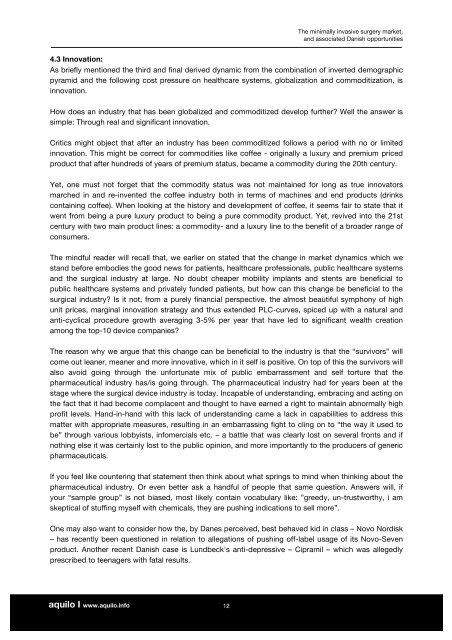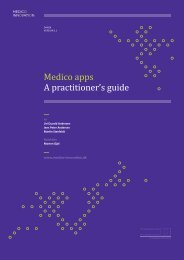The minimally invasive surgery market, and associated Danish ...
The minimally invasive surgery market, and associated Danish ...
The minimally invasive surgery market, and associated Danish ...
Create successful ePaper yourself
Turn your PDF publications into a flip-book with our unique Google optimized e-Paper software.
aquilo I www.aquilo.info<br />
12<br />
<strong>The</strong> <strong>minimally</strong> <strong>invasive</strong> <strong>surgery</strong> <strong>market</strong>,<br />
<strong>and</strong> <strong>associated</strong> <strong>Danish</strong> opportunities<br />
4.3 Innovation:<br />
As briefly mentioned the third <strong>and</strong> final derived dynamic from the combination of inverted demographic<br />
pyramid <strong>and</strong> the following cost pressure on healthcare systems, globalization <strong>and</strong> commoditization, is<br />
innovation.<br />
How does an industry that has been globalized <strong>and</strong> commoditized develop further? Well the answer is<br />
simple: Through real <strong>and</strong> significant innovation.<br />
Critics might object that after an industry has been commoditized follows a period with no or limited<br />
innovation. This might be correct for commodities like coffee - originally a luxury <strong>and</strong> premium priced<br />
product that after hundreds of years of premium status, became a commodity during the 20th century.<br />
Yet, one must not forget that the commodity status was not maintained for long as true innovators<br />
marched in <strong>and</strong> re-invented the coffee industry both in terms of machines <strong>and</strong> end products (drinks<br />
containing coffee). When looking at the history <strong>and</strong> development of coffee, it seems fair to state that it<br />
went from being a pure luxury product to being a pure commodity product. Yet, revived into the 21st<br />
century with two main product lines: a commodity- <strong>and</strong> a luxury line to the benefit of a broader range of<br />
consumers.<br />
<strong>The</strong> mindful reader will recall that, we earlier on stated that the change in <strong>market</strong> dynamics which we<br />
st<strong>and</strong> before embodies the good news for patients, healthcare professionals, public healthcare systems<br />
<strong>and</strong> the surgical industry at large. No doubt cheaper mobility implants <strong>and</strong> stents are beneficial to<br />
public healthcare systems <strong>and</strong> privately funded patients, but how can this change be beneficial to the<br />
surgical industry? Is it not, from a purely financial perspective, the almost beautiful symphony of high<br />
unit prices, marginal innovation strategy <strong>and</strong> thus extended PLC-curves, spiced up with a natural <strong>and</strong><br />
anti-cyclical procedure growth averaging 3-5% per year that have led to significant wealth creation<br />
among the top-10 device companies?<br />
<strong>The</strong> reason why we argue that this change can be beneficial to the industry is that the “survivors” will<br />
come out leaner, meaner <strong>and</strong> more innovative, which in it self is positive. On top of this the survivors will<br />
also avoid going through the unfortunate mix of public embarrassment <strong>and</strong> self torture that the<br />
pharmaceutical industry has/is going through. <strong>The</strong> pharmaceutical industry had for years been at the<br />
stage where the surgical device industry is today. Incapable of underst<strong>and</strong>ing, embracing <strong>and</strong> acting on<br />
the fact that it had become complacent <strong>and</strong> thought to have earned a right to maintain abnormally high<br />
profit levels. H<strong>and</strong>-in-h<strong>and</strong> with this lack of underst<strong>and</strong>ing came a lack in capabilities to address this<br />
matter with appropriate measures, resulting in an embarrassing fight to cling on to “the way it used to<br />
be” through various lobbyists, infomercials etc. – a battle that was clearly lost on several fronts <strong>and</strong> if<br />
nothing else it was certainly lost to the public opinion, <strong>and</strong> more importantly to the producers of generic<br />
pharmaceuticals.<br />
If you feel like countering that statement then think about what springs to mind when thinking about the<br />
pharmaceutical industry. Or even better ask a h<strong>and</strong>ful of people that same question. Answers will, if<br />
your “sample group” is not biased, most likely contain vocabulary like: ”greedy, un-trustworthy, i am<br />
skeptical of stuffing myself with chemicals, they are pushing indications to sell more”.<br />
One may also want to consider how the, by Danes perceived, best behaved kid in class – Novo Nordisk<br />
– has recently been questioned in relation to allegations of pushing off-label usage of its Novo-Seven<br />
product. Another recent <strong>Danish</strong> case is Lundbeck's anti-depressive – Cipramil – which was allegedly<br />
prescribed to teenagers with fatal results.







